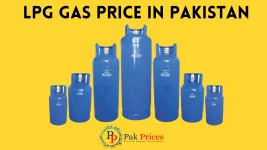LPG Price in Pakistan: An In-Depth Analysis
Introduction
Liquefied Petroleum Gas (LPG) plays a crucial role in Pakistan’s energy landscape, serving as a versatile source of fuel for a variety of applications. From cooking to heating and transportation, LPG is widely used across the country, particularly in areas where access to natural gas is limited. The price of LPG in Pakistan is a topic of significant interest and importance, as it directly impacts the daily lives of millions of Pakistanis.
This introduction will delve into the various aspects of the LPG market in Pakistan, exploring the factors that influence prices, the challenges faced by consumers and suppliers, and the government’s role in regulating the market. Additionally, we will examine the impact of international market trends and local policies on LPG prices, as well as the efforts being made to promote the use of LPG as a cleaner and more efficient energy source in Pakistan.
Overview of LPG Market in Pakistan
Pakistan is one of the largest consumers of LPG Price in Pakistan in the world, with a growing demand for this versatile fuel. The country’s LPG market is characterized by a mix of local production and imports, with the latter playing a significant role in meeting the country’s demand. Pakistan produces a portion of its LPG domestically, mainly through the extraction of natural gas liquids (NGLs) during the production of natural gas. However, the country still relies heavily on imports to meet its growing demand for LPG.

LPG market in Pakistan
The LPG market in Pakistan is primarily driven by the residential sector, where it is used for cooking and heating purposes. Additionally, LPG is widely used in the commercial and industrial sectors, as well as in the transportation sector, where it is used as an alternative fuel for vehicles. The widespread use of LPG in Pakistan can be attributed to its affordability, efficiency, and versatility, making it a popular choice among consumers.
Factors Influencing LPG Prices
Several factors influence the price of LPG in Pakistan, including international market trends, exchange rates, government policies, and domestic production levels. The price of LPG is closely linked to the price of crude oil, as LPG is a by-product of the refining process. Therefore, fluctuations in the price of crude oil can have a direct impact on the price of LPG.
Exchange rates also play a significant role in determining the price of LPG in Pakistan, as the country imports a large portion of its LPG. A stronger Pakistani Rupee can lead to lower import costs, which can result in lower LPG prices for consumers. Conversely, a weaker Rupee can lead to higher import costs and higher LPG prices.
Government policies and regulations also influence the price of LPG in Pakistan. The government sets the maximum retail price of LPG, which is based on a formula that takes into account international prices, exchange rates, and local taxes and duties. Additionally, the government provides subsidies for LPG consumers, particularly in remote and underserved areas, to ensure that LPG remains an affordable fuel option for all.
Challenges Faced by Consumers and Suppliers
Despite its many benefits, the LPG market in Pakistan faces several challenges that affect both consumers and suppliers. One of the main challenges is the lack of infrastructure for the storage, transportation, and distribution of LPG. This results in supply chain inefficiencies and can lead to shortages and price fluctuations in the market.
LPG suppliers
Another challenge is the presence of unregulated and illegal LPG suppliers, who often sell substandard or adulterated LPG at lower prices. These illegal suppliers not only pose a safety risk but also undermine the efforts of legitimate suppliers to maintain quality and safety standards in the market.
Additionally, the high cost of LPG cylinders and refills can be a barrier for many consumers, particularly those in low-income households.
Government Regulations and Policies
The government of Pakistan plays a crucial role in regulating the LPG market and ensuring the availability of affordable LPG for consumers. The Oil and Gas Regulatory Authority (OGRA) is responsible for regulating the import, storage, transportation, and distribution of LPG in Pakistan. OGRA sets the maximum retail price of LPG based on a formula that takes into account international prices, exchange rates, and local taxes and duties.
The government also provides subsidies for LPG consumers, particularly in remote and underserved areas, to ensure that LPG remains an affordable fuel option for all. Additionally, the government has implemented safety regulations and standards to ensure the safe handling, storage, and use of LPG.
Promoting LPG as a Clean Energy Source
In recent years, there has been a growing focus on promoting LPG as a cleaner and more efficient energy source in Pakistan. The government, along with industry stakeholders, has been working to raise awareness about the benefits of LPG and encourage its use as an alternative to traditional fuels such as wood, coal, and kerosene.
Additionally, LPG is a more efficient fuel, which means that it produces more heat per unit of fuel compared to other fuels. This makes it a cost-effective option for consumers and can help reduce energy costs in the long run.
Introduction to LPG Economics
Liquefied Petroleum Gas (LPG) is a vital energy source in Pakistan, powering homes, businesses, and vehicles. The pricing of LPG is a subject of national interest, affecting the budget of millions.
The Significance of LPG
LPG is not just a commodity; it’s a lifeline for many LPG Price in Pakistan, especially in areas where natural gas is not available. Its importance in daily life makes understanding its pricing crucial. By basing the LPG price on global rates, OGRA makes sure that local prices are reasonable and competitive for all parties.
The Regulatory Framework
The Oil and Gas Regulatory Authority (OGRA) is responsible for overseeing the LPG prices in Pakistan. OGRA’s decisions impact the entire supply chain, from importers to end consumers.
OGRA’s Pricing Mechanism
OGRA sets the LPG price based on international rates, ensuring that the domestic prices are competitive and fair for all stakeholders involved.
Current Trends in LPG Pricing
As of April 2024, the LPG price set by OGRA is PKR 250.34 per kg.This rate is inclusive of an 18% GST, reflecting the latest international market trends1.
Market Fluctuations
Despite OGRA’s regulated cost, the real market price might fluctuate, with values ranging from PKR 270 to PKR 300 per kilogram.
LPG’s Role in Pakistan’s Energy Mix
LPG serves as a crucial alternative energy source, particularly during the winter months when SNGPL faces load shedding issues.
The Domestic and Transportation Sectors
It’s also a popular fuel choice for auto-rickshaws, contributing to the transportation sector’s energy diversity.
The Future of LPG in Pakistan
Looking ahead, the LPG industry in Pakistan has the potential to grow. With government initiatives aimed at stabilizing prices and ensuring supply, the future looks promising tribuneinsights.
Conclusion
The LPG price in Pakistan is a dynamic figure that reflects the interplay of global markets and local regulatory decisions. “Pakprices” is dedicated to providing up-to-date and accurate information on LPG pricing, helping consumers navigate this essential market and stay connected to tribuneinsights.
FAQs on LPG Prices
- What is the current LPG price per kg in Pakistan?
- As of April 2024, it’s PKR 250.34 per kg, per OGRA’s notification1.
- Why do market prices of LPG differ from OGRA’s rates?
- Market prices can vary due to additional distribution costs and regional supply-demand factors.
- How often does OGRA update LPG prices?
- OGRA updates LPG prices monthly based on international market trends.
- Where can I find reliable updates on LPG prices?
- “Pakprices” provides regular updates on LPG prices, ensuring you have the latest information.
- Is LPG a cost-effective alternative to natural gas?
- LPG is a reliable alternative, especially during natural gas shortages, though it may be more expensive.


